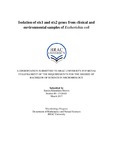| dc.contributor.advisor | Mosharraf, Fahareen Binta | |
| dc.contributor.author | Shuvra, Samira Khandaker | |
| dc.date.accessioned | 2018-01-17T06:20:58Z | |
| dc.date.available | 2018-01-17T06:20:58Z | |
| dc.date.copyright | 2017 | |
| dc.date.issued | 2017-03 | |
| dc.identifier.other | ID 13126021 | |
| dc.identifier.uri | http://hdl.handle.net/10361/9094 | |
| dc.description | This thesis report is submitted in partial fulfillment of the requirement for the degree of B.Sc in Microbiology, 2017. | en_US |
| dc.description | Cataloged from PDF version of thesis report. | |
| dc.description | Includes bibliographical references (pages 34-36). | |
| dc.description.abstract | E. coli O157:H7, a Shiga toxin producing microbe was first acknowledged as a virulent organism
in 1982 during an analysis of an outbreak of hemorrhagic colitis associated with consumption of
hamburgers from a fast food chain restaurant. Ability of E. coli O157:H7 to induce injury in
humans is a result of its ability to produce numerous virulence factors, most notably Shiga toxins
Stx1 and Stx2, both of which constitute one of the most potent toxins known to man. Besides,
Shiga toxin, E. coli O157:H7 produces several other virulence factors, which include proteins
which aid in the attachment and colonization of the bacteria in the intestinal wall and which can
break down red blood cells and release iron to help support metabolism in E. coli . Virulence
factors facilitate this organism’s ability to cause intestinal and extra-intestinal diseases such as
diarrhea, hemorrhagic colitis (HC), hemolytic uremic syndrome (HUS), urinary tract infections
(UTI), septicemia and neonatal meningitis. In this study r, 7 samples from Dhaka city was
collected, cultured in various media for enumeration, isolation and screening of E. coli colonies
which were further analyzed to check for the presence of stx genes using PCR and gel
electrophoresis. The seven samples collected were: Door knob swab, tea water, bhel puri, kitchen
pipe swab, vegetable water, Lake water and Rectal swab. The samples collected initially were
enriched in enrichment media overnight, followed by a dilution series which were then used for
spread plating on nutrient agar and MacConkey agar and EMB for confirmation with the
observation of pink colonies and metallic sheen. The confirmed E. coli isolates were later
subjected to DNA extraction and amplification after which the bands for stx genes were observed
and recorded. Out of the seven samples tested for stx1 and stx2 genes, two showed the presence
of stx1 genes and one showed the presence of stx2 gene. The presence of the stx1 and stx2 genes
in regular food and in our surrounding signifies how close we are to a large outbreak. Knowledge
of processing such food or avoiding such environmental contacts or taking precautions when
possible may prevent occurrence of diseases. | en_US |
| dc.description.statementofresponsibility | Samira Khandaker Shuvra | |
| dc.format.extent | 40 pages | |
| dc.language.iso | en | en_US |
| dc.publisher | BRAC University | en_US |
| dc.rights | BRAC University thesis are protected by copyright. They may be viewed from this source for any purpose, but reproduction or distribution in any format is prohibited without written permission. | |
| dc.subject | E. coli O157:H7 | en_US |
| dc.subject | stx1, stx2 genes | en_US |
| dc.title | Isolation of stx1 and stx2 genes from clinical and environmental samples of Escherichia coli | en_US |
| dc.type | Thesis | en_US |
| dc.contributor.department | Department of Mathematics and Natural Sciences, BRAC University | |
| dc.description.degree | B. Mircobiology | |

